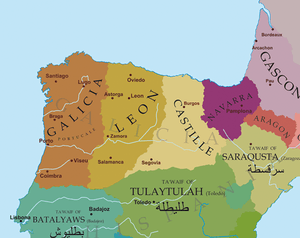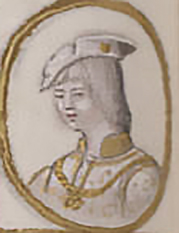García II of Galicia facts for kids
García II (born 1041/1043, died 1090) was a king of Galicia. He was the youngest of three sons of King Ferdinand I and Sancha of León. His mother's family owned the lands that García would later rule. García is first mentioned in a document from 1064, which his father approved.
Becoming King

In 1065, King Ferdinand I divided his kingdom among his sons. García received the County of Galicia, which was made into a kingdom. This kingdom stretched south into Portugal to the Mondego River. It also received payments (called parias) from the Muslim kingdoms of Badajoz and Seville.
His oldest brother, Sancho, received the Kingdom of Castile and payments from Zaragoza. The middle son, Alfonso, received the largest share: an expanded Kingdom of León. This kingdom included lands that had traditionally belonged to Castile and Galicia.
García's kingdom of Galicia was the most challenging to rule. It included lands south of the Duero River that had only recently been brought back under royal control. Also, his father had started to reduce the power of local nobles, but this process was not finished when he died. Adding to the problems, the bishops of Lugo and Santiago were competing for power.
Wars Between Brothers
One of García's first actions was to take control of most of a powerful nobleman's lands. He also planned to bring back bishoprics in Braga, Lamego, and Tui. These actions were meant to strengthen his royal power. However, he faced a major setback in 1068 when the Bishop of Santiago died, and his successor was killed the next year. This event showed a weakening of García's authority in Galicia.
García then focused on strengthening his control in the southern parts of his kingdom. There, he faced a challenge from a rebel, Count Nuno Mendes, in early 1071. García defeated and killed Nuno Mendes at the Battle of Pedroso.
García's brother, Alfonso, had been watching the unstable situation in Galicia since at least 1070. In May or June 1071, Alfonso invaded Galicia and northern Portugal. Sancho, the eldest brother, likely agreed to this. This situation was difficult because Alfonso's kingdom separated Sancho from Galicia. Sancho probably attacked León in 1072 because he feared Alfonso was becoming too powerful. Alfonso was defeated and sent away.
Sancho then turned his attention to García in central Portugal. He defeated García near Santarém and briefly imprisoned him in Castile. García was then allowed to escape to Seville. This brought the kingdoms that their father had divided back together. García's independent kingdom of Galicia and Portugal no longer existed.
Imprisonment and Death
Later in 1072, events led to García's return. Sancho was killed at Zamora while trying to stop a rebellion. This rebellion was led by their sister Urraca and a nobleman named Pedro Ansúrez. Both dethroned brothers, Alfonso and García, returned north. Alfonso then took control of all the reunited kingdoms.
It is not clear if García hoped to get his kingdom back or if Alfonso had promised him safety. But in February 1073, García was invited to a meeting with Alfonso and was captured there. Early records do not say where he was imprisoned, but later stories say it was at Luna castle, near León. He remained there until his death in 1090. He died from a fever after a medical procedure called bloodletting.
King García had wished to be buried in chains, just as he had lived his final days. His tomb in the royal burial place at the Basílica de San Isidoro, León showed him in chains. It had an inscription in Latin, which has since been destroyed. It reportedly said:
- Here lies Lord Garcia King of Portugal and Galicia, son of the great king Ferdinand. He was captured by his brother using a trick and placed in chains. He died on March 22, 1090.
Historians believe this inscription might mean that García was the first to use the title "King of Portugal." Before him, Portugal was ruled by a count. Six years after García died, Portugal became a county again, given to Henry of Burgundy. Henry's son, Afonso Henriques, later became the first crowned King of Portugal.
Because García died while an important church meeting was happening, many important religious leaders attended his funeral. This included Reniere, who would later become Pope Pascal II.
García's capture by trickery, his long imprisonment, and his grand burial made him a popular subject for poets. By the mid-1100s, many poems about him existed. The oldest one that still survives is a ballad from the 1500s called Muerte de don García, rey de Galicia, desposeído por sus hermanos Sancho II y Alfonso VI de Castilla (The Death of García, king of Galicia, dispossessed by his brothers Sancho II and Alfonso VI of Castile).
See also
 In Spanish: García de Galicia para niños
In Spanish: García de Galicia para niños


